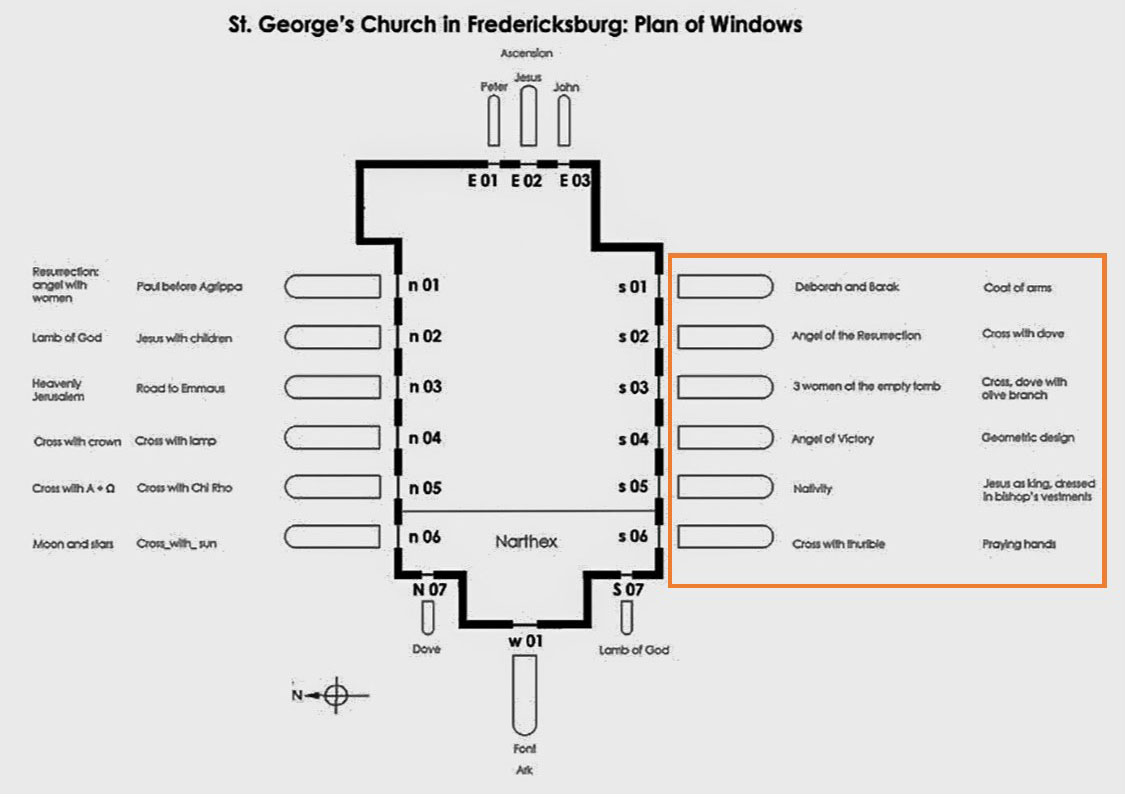
St. George’s windows in 1849 were originally filled with diamond-shaped clear glass. In 1885, the three windows in the east end of the church were filled with stained glass as a memorial to Rev. Edward McGuire, who served the church for 45 years. In 1906, the church had just been renovated, and stained-glass windows by Louis Tiffany and other makers were changing the insides of sanctuaries in America. Between 1907 and 1917, most of the rest of our church was reglazed with new stained-glass. The creators of the windows were Louis Tiffany and a number of other artists displaying various styles within the Arts and Crafts Movement. These windows brought a different light and color into the church.
The plan above shows the numbering of the windows. The tour features the lower ones, enclosed in a brown rectangle.
The windows are important for three reasons: 1. They were memorials to the donors and church members of the time 2. They teach Old and New Testament scripture. The windows often include the scriptures depicted. 3. They are art objects in themselves and use religious symbolism throughout.
To begin the tour go to the front of the church and to the right which is the south side. The tour will proceed down this side through six windows ending at the Cross with Thurible window. Then to reach the St. Paul window for the second part you would go to the front of the church and to the left which is the north side. This is Part 2 of the tour
| # | Window |
|---|---|
| S01 | Deborah and Barack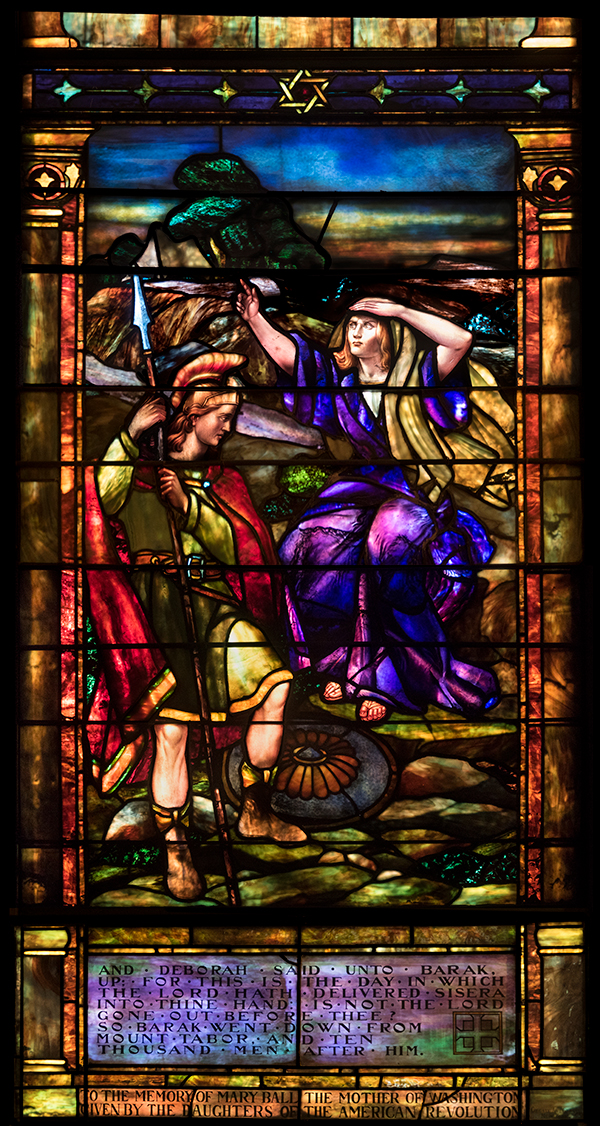
The window is in memory of Mary Ball Washington, Mother of George Washington, by the Daughters of the American Revolution. It was designed by the Colgate Art Glass Company in NY and dedicated in 1907. The subject of the window is the defeat of Canaanites under the prophetic leadership of Deborah and the military leadership of Barak, and is related in the Book of Judges. The window depicts Deborah pleading with Barak to lead the Israelites against the Canaanites. It is the only window with an Old Testament theme in our church. More information on the Deborah and Barak window. |
| S02 | Angel of the Resurrection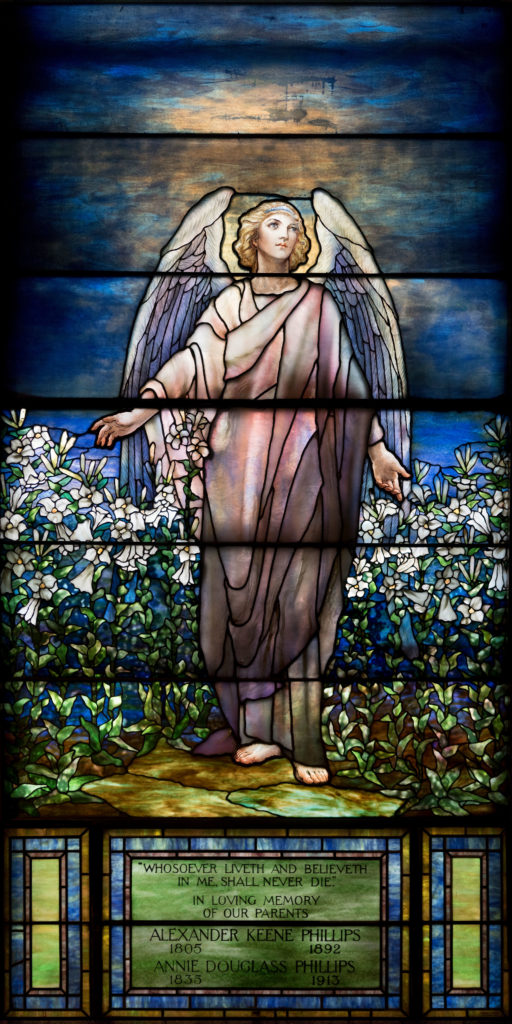
This is one of three Tiffanies at St. George’s. It was dedicated in 1914 to Alexander Phillips and his wife. He became the first president of the National Bank of Fredericksburg in 1865 and had been previously involved in many businesses, including grain and mercantile. The inscription, “…Whosoever liveth and believeth in me shall never die.” is from John 11:26. In this window, the angel is sitting in a field of snow-white lilies, clad in robes of pink. The windows show Tiffany’s work in drapery glass for the angel’s robes that are close to fabric folds. Tiffany’s use of glass plays well with the sun which strikes the window in the morning hours. It accentuates the paint and enamel in the face and hands. The yellow-streaked, sun-dappled clouds depict a dawn-sky, a common metaphor for rebirth and resurrection. More information on the Angel of the Resurrection. |
| S03 | Three Women at the Empty Tomb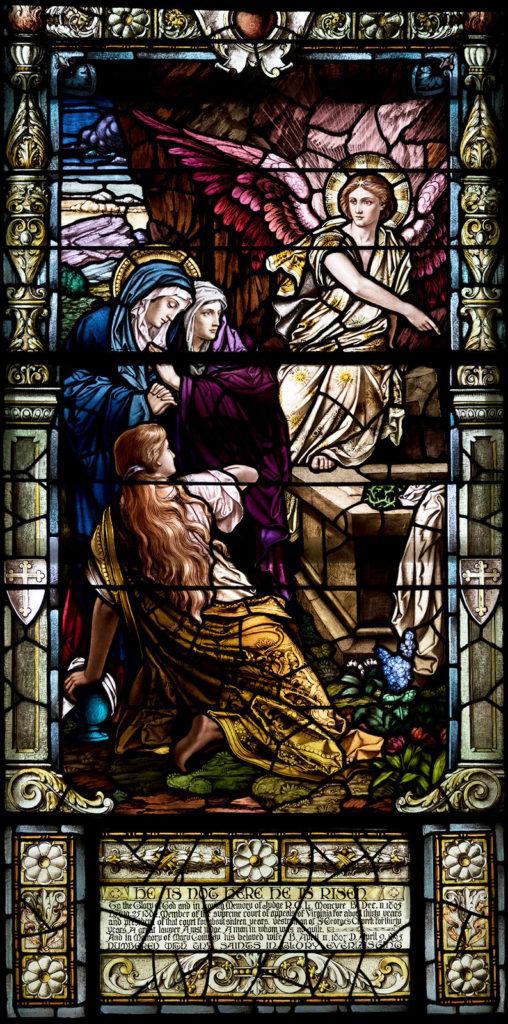
The window is dedicated to Judge R.C.L. Moncure, “a man in whom was no guile.” Moncure was a prominent lawyer, reaching the rank of president of Va. Court of Appeals. Based on similar work in Front Royal, we think this window was made by George Hardy Payne in 1908. It is based on an earlier painting of the same subject by the German artist Bernhard Plockhorst. The window depicts the shock of the open and Jesus not being there. Artistically, the drama of the event is conveyed by the angel pointing to the empty tomb and Mary Magdalene recoiling from the news. The action shifts from top right to bottom left with the two other figures remaining somewhat calm, but comforting each other, providing a contrast to the other characters. This story of the Resurrection is taken from Mark. Mark lists the women in the window as Mary Magdalene, Mary the mother of James and Salome, a follower of Jesus and possibly Mary’s sister. More information on the Three Women at the Empty Tomb. |
| S04 | Angel of Victory 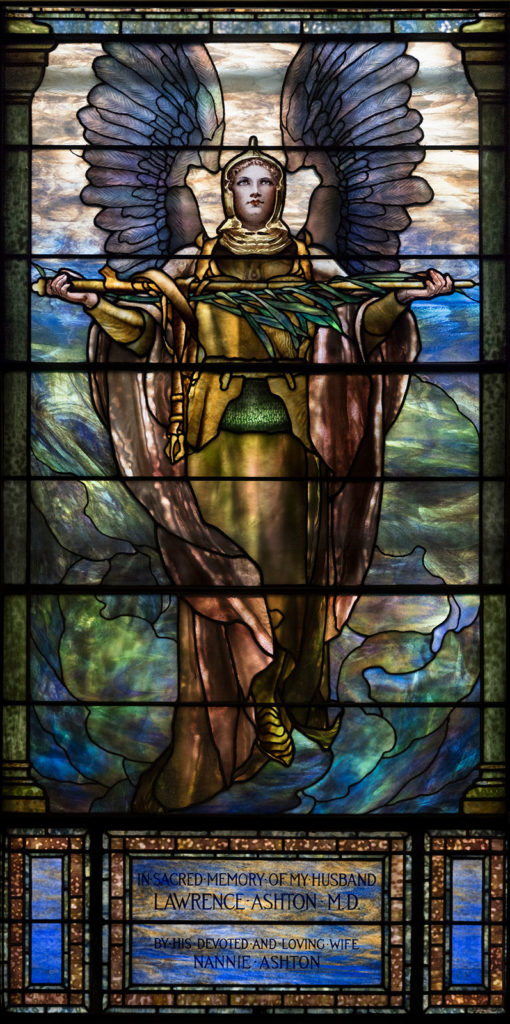
This window was placed by Nannie Green, the widow of Lawrence Ashton, M.D. Green was the daughter of Duff Green, Falmouth merchant and original pew holder. Dr. Ashton was one of the most prominent doctors of his day in Virginia. As vice-president of the Virginia Medical Society for 8 years and president for one, he was the originator of the law to regulate the practice of medicine. The window is our last Tiffany, 1917. The angel is wearing a breastplate over armor and holding a sword and buckler which symbolizes the victory of the triumphant march into Jerusalem. The palms also symbolize the Resurrection victory over death. The angel is surrounded by a collage of opalescent glass of green, blues and purples. More information on the Angel of Victory |
| S05 | Nativity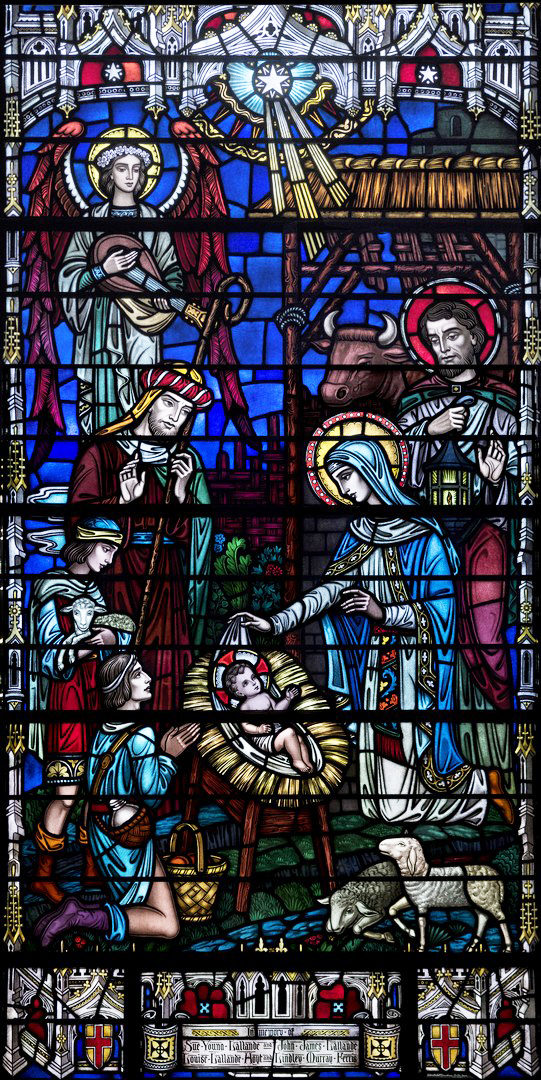
This window was created by Wilbur Burnham of Boston and is our latest window in 1943. The window was in memory of the Lallande family. Their relative John J. Young had served on the Vestry periodically from 1847 until 1901 and was a prominent businessman. Wilbur Herbert Burnham of Boston and is our latest window dating from 1943. Burnham was a follower of the Arts and Crafts movement that migrated to the US from Great Britain in the 19th century. His work is considered part of the neo-gothic movement in the early 20th century. He worked in the style of the great medieval cathedrals in France of the 13th century and was opposed to the more painterly style used by Tiffany. The star and the Baby Jesus neatly divide the scene with a touch of the rose for new life just above Jesus. Mary and Joseph on the right are clearly separated from the visitors on the left. It is very iconic, inclusive and balanced – the two shepherds, one King and the angel strumming a lute on the left against the other characters. More information on the Nativity window. |
| S06 | Cross with Thurible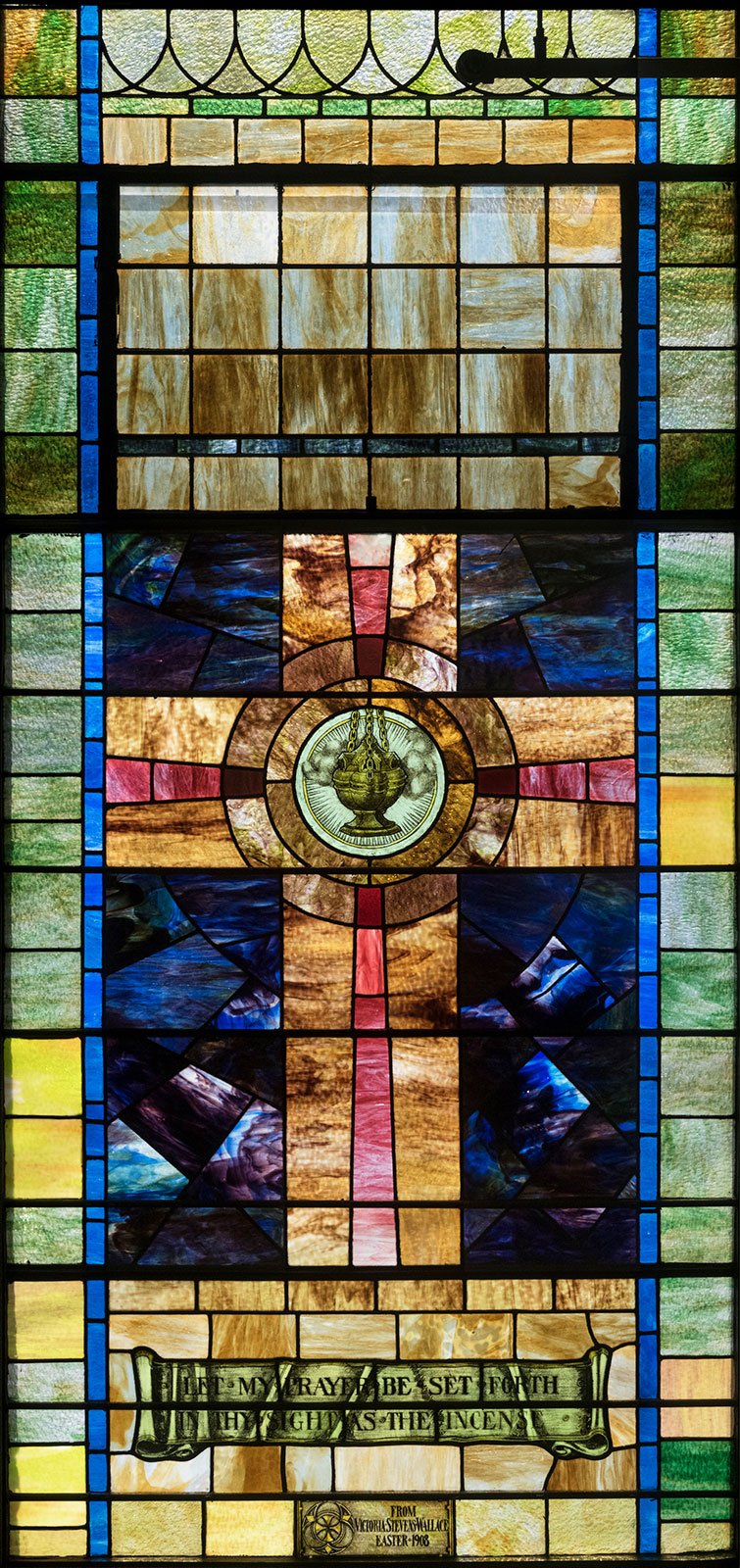
This was one of the windows given by Victoria S. Wallace in 1908. The window was made by Charles Hogeman. The scripture is from Psalm 141:2: “Let my prayer be set forth before thee as incense.” A cross shines forth out of a dark blue background. Different rows are filled with different shapes of stones. In the center of the cross, we find a thurible, surrounded by two concentric circles. A thurible is a censer suspended from chains, in which incense is burned during worship services. There are numerous Biblical references to censers from Leviticus to Revelation. It was used to freshen the air as well as the smoke going to heaven as well as our prayers. More information on the Cross with Thurible window. |
This windows ends part 1 of the lower windows. Go to the front of the church and then left which is north to pick up Part 2 of the tour.